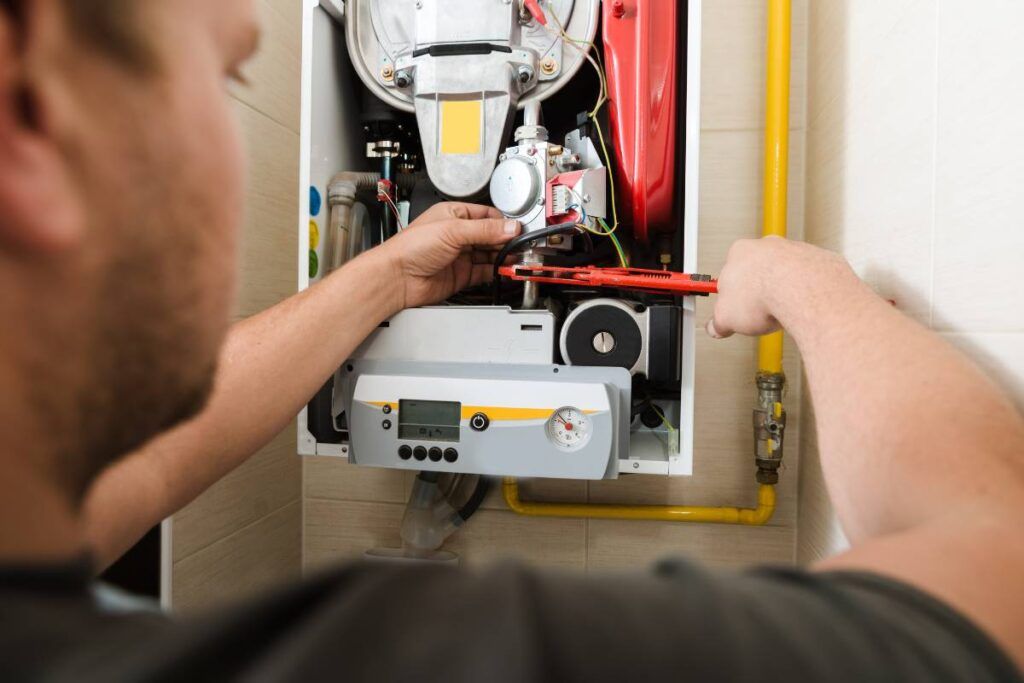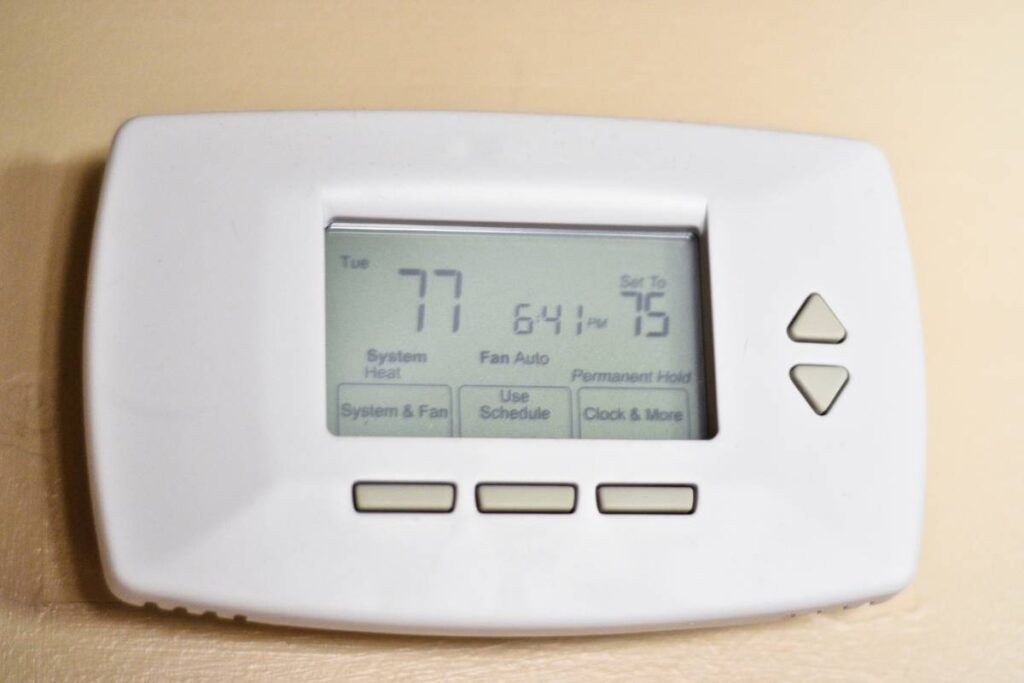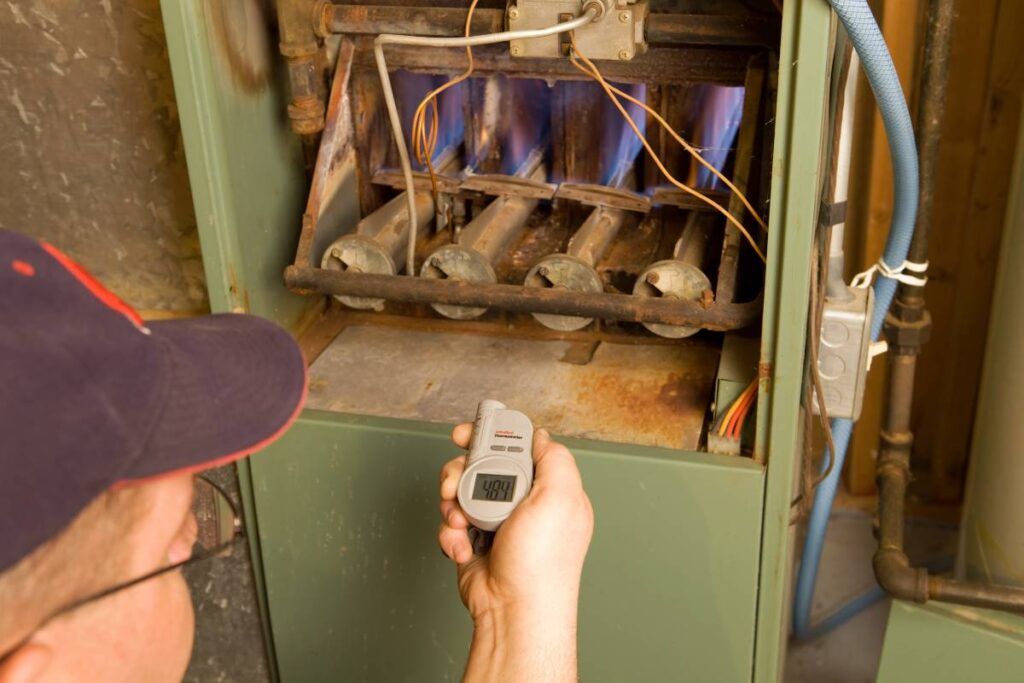When winter arrives, all we care about is an efficient furnace to receive warm and comfortable air inside the house. But it is stressful to see the furnace blowing cold air. Today, we shall explore the reasons behind a furnace blowing cold air.
The major reasons your furnace blows cold air are incorrect thermostat settings, dirty filters, clogged condensate lines, insufficient gas, leaky ducts, and dirty flame sensor. To fix it, clean the filters, condensate lines, and flame sensors, check for gas supply, and repair the ducts if needed.
There is more in the list, and this article will explain all the possible reasons behind a furnace blowing cold air. Always hire a professional if you cannot understand or fix the problem yourself.

Check out our list of top-handpicked products for all your electrical, appliance, and HVAC system needs to keep your home running smoothly.
This post includes some affiliate links.Why does a furnace blow cold air?
A furnace is an integral part of the house, especially during winter.
It helps produce warm air throughout your house in the winter to keep you comfortable.
But, if the furnace produces cold air, it does not serve its purpose.
It is because the furnace might be facing some issues.
The problems can begin with the wrong thermostat setting and end with air leaks and everything in between them.
We have enlisted all the possible reasons behind a furnace blowing cold air and the ways to troubleshoot each of them:
1. The furnace is yet to warm up
When everything is fine in your furnace but still gives you an icy blast of cold air, it will build up a sense of panic.
If you are a beginner in using a furnace for the first time, you should know that the furnace will take some time to warm up the air.
Once you turn on the furnace, wait for some minutes to let the unit warm up the air slowly.
After turning the furnace on, the unit will start its heating cycle after 10 to 15 minutes to give you the desired warm temperature.
2. Thermostat issues
A thermostat problem is considered one of the major problems behind a furnace blowing cold air.
A thermostat regulates the functioning of the furnace and signals the unit when to run and stop the warm air.
So, if the setting is wrong in the thermostat, your furnace might blow cold air instead of warm air.
The blower will keep running even if the heating is off, therefore, making a chilly condition inside your house.
Another problem with the thermostat is the wire issues.
The newly installed thermostats might have incorrect or incompatible wires.
As a result, the thermostat will send wrong signals to the furnace, for which the unit may blow cold air.
Solution

You must set the thermostat to HEAT to receive warm air throughout your house.
Another setting should be done for the fan. Please set it to AUTO instead of ON.
Keeping it ON means the fan constantly runs, with or without heat.
If the thermostat is not working and jumping the values, consider replacing it.
But if everything is correct, your furnace should start blowing warm air after a few seconds of the correct settings.
It would be best to have HVAC guidance to fix the wire issues.
3. The pilot light is off
The old gas furnaces have a pilot light that should light up whenever your unit runs.
The pilot light must remain on when you turn on the furnace.
It ensures that the furnace is supplied with gas.
The heating process will not start if the pilot light is off.
Otherwise, your furnace will receive cold air if the pilot does not light up.
A pilot light may go out due to a strong wind, a blocked pilot orifice, or a defective pilot system.
First, determine whether the pilot light is in good condition and can function well.
If the pilot light is a standing pilot, it must have a small flame.
Check if you can see the flame.
You will also hear a spark when the pilot lights or see a hot furnace ignitor glow.
Solution
Here are the steps to relight the pilot light:
- Turn off the furnace power at the breaker box.
- Find the pilot light. Turn off the gas valve and wait until the gas escapes the pilot light.
- Turn the gas valve to PILOT. Press and hold the reset button near the gas valve.
- While holding the reset button, press the ignitor to lighten the gas from the pilot.
- You can also use a BBQ lighter or a long match to light the pilot. Continue holding the reset button for at least 20 to 30 seconds.
- Turn back the gas valve and power your furnace.
Call an HVAC expert to help you if these steps do not work.
4. Defective flame sensor
The furnace flame or ignition sensor is a thin, bent metal rod over the porcelain base burner assembly in front of the pilot light.
When the furnace is on, gas comes out from the gas valve into the combustion chamber, and the pilot lights the burners.
The flame sensor confirms that the flames are burning after the gas valve opens.
If the sensor cannot detect the flames when the gas turns on, it will shut down the system to save your house from getting loaded with toxic gas.
The flame sensor can accumulate dirt, soot, and carbon deposits over time from the flames.
A dirty or faulty ignition sensor cannot properly detect the flames.
It will shut down the furnace, but cold air will blow from the vents because the fan will remain on.
The air becomes cold because the heat exchanger heats up until the flame sensor turns off the burners.
Solution

You can test the flame once by turning off the unit for 5-10 minutes and then starting it on.
If the problem remains, the sensor is either dirty or faulty.
Here are the steps to clean or replace the dirty or faulty flame sensors:
- Turn off the furnace power at the circuit breaker.
- Remove the access panel of the unit, and find the flame sensor.
- It will look like a bent metal rod with white porcelain at the mounting end.
- Remove the screws and slide out the rod gently.
- If the sensor’s tip is black, rub the metal part with steel wood or emery cloth. You can also use a knife to scrape the dirt.
- If the porcelain part has cracks, replace the sensor.
- After cleaning, put the sensor back in its place and screw it tightly. Put back the access panel.
- Turn on your furnace.
If you still face the same issue, call an HVAC expert.
5. Cracked heat exchanger
A furnace blowing cold air could be due to a cracked heat exchanger because it will fail the ignition.
A cracked heat exchanger can also overheat your unit, trigger the main limit switch, and shut down your furnace.
But the fan will be on until the whole system shuts down, and your furnace will blow cold air.
Solution
When you have a cracked heat exchanger, your house will face carbon monoxide poisoning.
You must immediately turn off your furnace and hire an HVAC expert to replace the heat exchanger.
6. Overheating
Reasons behind overheating are dirty filters, mechanical failure, or old units.
Overheating will make your unit shut down the cycle. The fans will remain on and release cold air into your house.
Restart your furnace to see if the problem goes away.
If the unit still overheats, find the reason behind overheating.
When a unit overheats, the high-limit switch gets activated.
It shuts off the system to prevent a fire, carbon monoxide leak, or explosion.
Cold air will blow from the vents until the entire system shuts down.
A bad exchanger will fail the ignition, and the furnace will not release the warm air.
But since the fan will be on, the unit may release cold air.
The air will struggle to pass through the dirty air filter.
As a result, your furnace will overheat and turn off.
But the unit will blow cold air because the fan will remain on and won’t turn off until the entire system shuts down.
Sometimes, the reason behind a furnace blowing cold air is old age.
Over time, the unit will lose efficiency, work harder to provide warm air, and overheat.

Solution
You need an HVAC expert to fix the heat exchanger.
Change the filters every 3 to 4 months, or clean them every 1-2 weeks.
A furnace lasts for 15 to 20 years. If your unit is old enough, replace the old unit with a new one.
7. Low gas supply
A gas furnace will need a pre-defined gas pressure to run properly and circulate warm air.
A gas furnace will not be able to operate if the gas pressure is low due to insufficient gas or other interruption.
Other reasons include closed gas valves or gas pipe leaks.
Without adequate gas, the furnace will not give you warm air and will blow out cold air whenever you turn it on.
Solution
You need to turn off the unit and gas valve and call an HVAC technician to check for the problem.
If your furnace uses propane or natural gas, call your gas provider to refill your empty tank or to check out for any service interruption.
If it is not the gas supply, ensure the gas valve is open when your furnace is running.
8. A faulty circuit control board
The furnace’s control board is the unit’s brain as it passes instructions to its various parts for proper functioning.
When the control board receives the heating cycle signal from the thermostat, it will send a signal to the furnace blower and furnace burner.
If the board is at fault, the blower may turn on, but not the furnace burners.
So, if your furnace is blowing cold air, it could be due to the faulty circuit control board.
There could be many reasons behind the failure, with lack of maintenance being common.
You must check for leaking water because water dripping on the control board can corrupt and disable the furnace parts.
Solution

It is an electrical problem.
You might need a professional technician to fix the control board.
9. Blocked air filters
The air filters in the furnace are behind the return air vent to trap the dirt and debris of the air particles and filter the air.
Filtering the air will keep the air supply clean and healthy.
Since the filters filter the air, they can become blocked due to the excessive accumulation of dirt and debris after a few months.
Once there is a blockage, air cannot pass through the furnace and give your house the desired temperature.
So, your furnace will struggle to give you a warm temperature and overheat.
Overheating will turn off the furnace cycle to prevent fire.
The burners will be off, but the fans will run and produce cold air.
Solution
The only solution to this problem is to clear the filters every 1-2 weeks or replace them every 3 to 4 months.
Ensure the filters installed are always clean and fresh at the beginning of every heating system.
10. Leaky air ducts
Ducts run through your house to give you hot air from the furnace throughout your house.
The ducts must be sealed properly so that no air can escape from openings.
If the ducts are leaking, the hot air will escape from the leaks, and the air you receive will feel cold when it reaches the vents.
Leaks are difficult to spot.
However, check it by walking along the ductwork.
Solution

It is not something you can fix. You can only confirm the problem and inform your local HVAC experts.
The experts will check for leaks and damage levels and seal or replace the ducts.
11. Clogged condensate lines
The high-efficiency furnaces have two heat exchangers, for which they condensate more and produce water.
This water drains into the PVC pipe called the condensate lines.
Condensate lines clogging over time with dirt and debris are natural.
Water can accumulate around the unit if the condensate gets clogged.
As a safety measure, the furnace will shut down.
But since the fan will be on from the thermostat setting, the furnace will continue circulating air throughout your house. But it will be cold air.
You can confirm the problem if your furnace has a damp feeling or it is leaking water.
Solution
You must unclog the condensate lines so your furnace can blow hot air again.
Here are the steps to unclog the condensate lines:
- Turn off the furnace power at the circuit breaker.
- Find out the condensate pan of your furnace and dry up the water in the pan with a wet or dry vacuum.
- Remove the pan to wash it with dish soap and water. Replace it if it is broken.
- Follow the condensate line from the pan until its ends. The line will end outside the house.
- Use a wet or dry vacuum to suck out all the dirt and debris from the end of the line.
- After cleaning, turn on your furnace to check.
If you cannot fix it properly, call an HVAC expert.
12. Clogged coil
The evaporator coil is a part of the cooling system.
Your furnace will have an evaporator coil inside it if you have a central air conditioner and the furnace.
Heat is absorbed from the surrounding air by the refrigerant in the HVAC’s evaporator coil,
Though the coil is a part of the cooling system, treated air passes through the coil due to its location to enter the duct.
The air will struggle to pass the coil if it is dirty or clogged.
Too much clogging will block the warm airflow and make your furnace release cold air.
Solution
To clean the evaporator coil:
- Remove the blower compartment panel and then the panel for the evaporator.
- Use soft towels to hand-clean the coil.
- Take a soft brush to clean the coil fins.
- Now, clean the blower compartment and assembly.
- Put everything back in place as it was before.
If you feel uncomfortable, call an HVAC expert to clean the coils.
Regular maintenance can prevent problems in the future

Some people forget about caring for the furnace once they install it and receive enough warmth.
But, you must care for the unit and perform regular maintenance and annual servicing.
Preventive care can reduce these problems and help you discover the issue before the unit shuts down.
- Replace the air filters regularly, for example, every 90 days or whenever they are dirty.
- Check the venting systems and accessory units before winter arrives.
- Confirm the security of the pipes, humidifiers, electronic air cleaners, and other things.
- Check for leakages and fix them immediately.
- Clean all the interior and exterior units. The blower wheel, fan motor, blades, and burners must be clean and free of rust and debris.
- Check for the electrical wiring and controls.
Also check:
- Furnace Only Works After Reset: 9 Problem+Fix
- 15 Reasons Your Furnace Won’t Turn On (+Fix)
- 14 Reasons Your Furnace Won’t Turn Off (+Fix)
Final thoughts
A furnace is meant to produce warm air in your house to make you comfortable in the winter.
But a furnace blowing cold air indicates a problem in the unit.
There could be several reasons behind it.
You can fix some simple issues, for example, wrong thermostat settings, dirty air filters, flame sensors, condensate lines, and evaporator coils.
Others, like cracked heat exchangers, damaged ductwork, faulty control board, thermostat wire issues, and issues in the pilot light, will need an HVAC expert’s attention.
Knowing the exact problem lets you know whether you can fix the problem or whether an HVAC is necessary and prevent you from delaying the troubleshooting.
Reference: Wikipedia.
